Liquid Biopsy Detecting Circulating Tumor Cells in Patients with Non-Small Cell Lung Cancer: Preliminary Results of a Pilot Study
Abstract
1. Introduction
2. Materials and Methods
2.1. Patient Cohort and Sample Collection
2.2. Red Blood Cells (RBCs) Lysis
2.3. SBS® Slide Technology
2.4. Immunostaining Protocol
2.5. CTCs Identification by Automated Microscopy Platform
2.6. Statistical Analysis
3. Results
3.1. Patient Characteristics
3.2. CTC Detection
3.3. CTCs and TTF-1 Immunostaining
3.4. Correlation between CTCs Count and Clinical and Pathological Characteristics
3.5. Gene Expression and BRAF Mutation
3.6. CTCs Count Associated with Survival
3.7. Cox Regression Analysis for Predictors of Survival
4. Discussion
5. Conclusions
Author Contributions
Funding
Institutional Review Board Statement
Informed Consent Statement
Data Availability Statement
Acknowledgments
Conflicts of Interest
References
- Bray, F.; Ferlay, J.; Soerjomataram, I.; Siegel, R.L.; Torre, L.A.; Jemal, A. Global cancer statistics 2018: GLOBOCAN estimates of incidence and mortality worldwide for 36 cancers in 185 countries. CA Cancer J. Clin. 2018, 68, 394–424. [Google Scholar] [CrossRef] [PubMed]
- Saarenheimo, J.; Eigeliene, N.; Andersen, H.; Tiirola, M.; Jekunen, A. The Value of Liquid Biopsies for Guiding Therapy Decisions in Non-small Cell Lung Cancer. Front. Oncol. 2019, 9, 129. [Google Scholar]
- Balata, H.; Evison, M.; Sharman, A.; Crosbie, P.; Booton, R. CT screening for lung cancer: Are we ready to implement in Europe? Lung Cancer 2019, 134, 25–33. [Google Scholar] [CrossRef] [PubMed]
- de Koning, H.J.; van der Aalst, C.M.; de Jong, P.A.; Scholten, E.T.; Nackaerts, K.; Heuvelmans, M.A.; Lammers, J.J.; Weenink, C.; Yousaf-Khan, U.; Horeweg, N.; et al. Reduced lung cancer mortality with volume CT screening in a randomized trial. N. Engl. J. Med. 2020, 382, 503–513. [Google Scholar] [CrossRef] [PubMed]
- Hofman, P. Liquid Biopsy for Lung Cancer Screening: Usefulness of Circulating Tumor Cells and Other Circulating Blood Biomarkers. Cancer Cytopathol. 2021, 129, 341–346. [Google Scholar] [CrossRef]
- Liu, W.-R.; Zhang, B.; Chen, C.; Li, Y.; Ye, X.; Tang, D.J.; Zhang, J.C.; Ma, J.; Zhou, Y.L.; Fan, X.J.; et al. Detection of circulating genetically abnormal cells in peripheral blood for early diagnosis of non-small cell lung cancer. Thorac. Cancer 2020, 11, 3234–3242. [Google Scholar] [CrossRef] [PubMed]
- Krol, I.; Schwab, F.D.; Carbone, R.; Ritter, M.; Picocci, S.; De Marni, M.L.; Stepien, G.; Franchi, G.M.; Zanardi, A.; Rissoglio, M.D.; et al. Detection of clustered circulating tumour cells in early breast cancer. Br. J. Cancer 2021, 125, 23–27. [Google Scholar] [CrossRef]
- Goldstraw, P.; Chansky, K.; Crowley, J.; Rami-Porta, R.; Asamura, H.; Eberhardt, W.E.; Nicholson, A.G.; Groome, P.; Mitchell, A.; Bolejack, V.; et al. The IASLC lung cancer staging project: Proposals for revision of the TNM stage groupings in the forthcoming (eighth) edition of the TNM classification for lung cancer. J. Thorac. Oncol. 2016, 11, 39–51. [Google Scholar] [CrossRef]
- Carbone, R.; Marangi, I.; Zanardi, A.; Giorgetti, L.; Chierici, E.; Berlanda, G.; Podestà, A.; Fiorentini, F.; Bongiorno, G.; Piseri, P.; et al. Biocompatibility of cluster-assembled nanostructured TiO2 with primary and cancer cells. Biomaterials 2006, 27, 3221–3229. [Google Scholar] [CrossRef]
- Carbone, R.; De Marni, M.; Zanardi, A.; Vinati, S.; Barborini, E.; Fornasari, L.; Milani, P. Characterization of cluster-assembled nanostructured titanium oxide coatings as substrates for protein arrays. Anal. Biochem. 2009, 394, 7–12. [Google Scholar] [CrossRef]
- Nakamura, N.; Miyagi, E.; Murata, S.; Kawaoi, A.; Katoh, R. Expression of thyroid transcription factor-1 in normal and neoplastic lung tissues. Mod. Pathol. 2002, 15, 1058–1067. [Google Scholar] [CrossRef] [PubMed]
- Pelosi, G.; Fraggetta, F.; Pasini, F.; Maisonneuve, P.; Sonzogni, A.; Iannucci, A.; Terzi, A.; Bresaola, E.; Valduga, F.; Lupo, C.; et al. Immunoreactivity for thyroid transcription factor-1 in stage I non-small cell carcinomas of the lung. Am. J. Surg. Pathol. 2001, 25, 363–372. [Google Scholar] [CrossRef]
- Hofman, V.; Ilie, M.I.; Long, E.; Selva, E.; Bonnetaud, C.; Molina, T.; Vénissac, N.; Mouroux, J.; Vielh, P.; Hofman, P. Detection of circulating tumor cells as a prognostic factor in patients undergoing radical surgery for non–small-cell lung carcinoma: Comparison of the efficacy of the CellSearch Assay™ and the isolation by size of epithelial tumor cell method. Int. J. Cancer 2011, 129, 1651–1660. [Google Scholar] [CrossRef] [PubMed]
- Chemi, F.; Rothwell, D.G.; McGranahan, N.; Gulati, S.; Abbosh, C.; Pearce, S.P.; Zhou, C.; Wilson, G.A.; Jamal-Hanjani, M.; Birkbak, N.; et al. Pulmonary venous circulating tumor cell dissemination before tumor resection and disease relapse. Nat. Med. 2019, 25, 1534–1539. [Google Scholar] [CrossRef]
- R Development Core Team. R: A Language and Environment for Statistical Computing; R Development Core Team: Vienna, Austria, 2019. [Google Scholar]
- Vona, G.; Sabile, A.; Louha, M.; Sitruk, V.; Romana, S.; Schütze, K.; Capron, F.; Franco, D.; Pazzagli, M.; Vekemans, M.; et al. Isolation by size of epithelial tumor cells: A new method for the immunomorphological and molecular characterization of circulating tumor cells. Am. J. Pathol. 2000, 156, 57–63. [Google Scholar] [CrossRef]
- Desitter, I.; Guerrouahen, B.S.; Benali-Furet, N.; Wechsler, J.; Jänne, P.A.; Kuang, Y.; Yanagita, M.; Wang, L.; Berkowitz, J.A.; Distel, R.J.; et al. A new device for rapid isolation by size and characterization of rare circulating tumor cells. Anticancer Res. 2011, 31, 427–441. [Google Scholar] [PubMed]
- Woo, D.; Yu, M. Circulating tumor cells as "liquid biopsies" to understand cancer metastasis. Transl. Res. 2018, 201, 128–135. [Google Scholar] [CrossRef]
- Allard, W.J.; Matera, J.; Miller, M.C.; Repollet, M.; Connelly, M.C.; Rao, C.; Tibbe, A.G.; Uhr, J.W.; Terstappen, L.W. Tumor cells circulate in the peripheral blood of all major carcinomas but not in healthy subjects or patients with nonmalignant diseases. Clin. Cancer Res. 2004, 10, 6897–6904. [Google Scholar] [CrossRef] [PubMed]
- Joosse, S.A.; Gorges, T.M.; Pantel, K. Biology, detection, and clinical implications of circulating tumor cells. EMBO Mol. Med. 2015, 7, 1–11. [Google Scholar] [CrossRef]
- Massard, C.; Borget, I.; Farace, F.; Aspeslagh, S.; Le Deley, M.C.; Le Tourneau, C.; Bidard, F.C.; Pierga, J.Y.; Dieras, V.; Hofman, P.; et al. RECIST response and variation of circulating tumour cells in phase 1 trials: A prospective multicentric study. Eur. J. Cancer 2017, 83, 185–193. [Google Scholar] [CrossRef]
- Wendel, M.; Bazhenova, L.; Boshuizen, R.; Kolatkar, A.; Honnatti, M.; Cho, E.H.; Marrinucci, D.; Sandhu, A.; Perricone, A.; Thistlethwaite, P.; et al. Fluid biopsy for circulating tumor cell identification in patients with early-and late-stage non-small cell lung cancer: A glimpse into lung cancer biology. Phys. Biol. 2012, 9, 016005. [Google Scholar] [CrossRef] [PubMed]
- Yoon, S.O.; Kim, Y.T.; Jung, K.C.; Jeon, Y.K.; Kim, B.-H.; Kim, C.-W. TTF-1 mRNA-positive circulating tumor cells in the peripheral blood predict poor prognosis in surgically resected non-small cell lung cancer patients. Lung Cancer 2011, 71, 209–216. [Google Scholar] [CrossRef]
- Satelli, A.; Li, S. Vimentin in cancer and its potential as a molecular target for cancer therapy. Cell. Mol. Life Sci. 2011, 68, 3033–3046. [Google Scholar] [CrossRef] [PubMed]
- Pirie-Shepherd, S.R.; Painter, C.; Whalen, P.; Vizcarra, P.; Roy, M.; Qian, J.; Franks, T.; Coskran, T.; Goals, J.; Deng, S.; et al. Detecting expression of 5T4 in CTCs and tumor samples from NSCLC patients. PLoS ONE 2017, 12, e0179561. [Google Scholar] [CrossRef]
- Nieto, M.A.; Huang, R.Y.; Jackson, R.A.; Thiery, J.P. EMT: 2016. Cell 2016, 166, 21–45. [Google Scholar] [CrossRef] [PubMed]
- Jou, H.J.; Ho, H.C.; Huang, K.Y.; Chen, C.Y.; Chen, S.W.; Lo, P.H.; Huang, P.W.; Huang, C.E.; Chen, M. Isolation of TTF-1 Positive Circulating Tumor Cells for Single-Cell Sequencing by Using an Automatic Platform Based on Microfluidic Devices. Int. J. Mol. Sci. 2022, 23, 15139. [Google Scholar] [CrossRef] [PubMed]
- Guibert, N.; Pradines, A.; Favre, G.; Mazieres, J. Current and future applications of liquid biopsy in nonsmall cell lung cancer from early to advanced stages. Eur. Respir. Rev. 2020, 29, 190052. [Google Scholar] [CrossRef] [PubMed]
- Li, Z.; Jiang, L.; Bai, H.; Wang, Z.; Zhao, J.; Duan, J.; Yang, X.; An, T.; Wang, J. Prevalence and clinical significance of BRAF V600E in Chinese patients with lung adenocarcinoma. Thorac. Cancer 2015, 6, 269–274. [Google Scholar] [CrossRef]
- Roviello, G.; D’Angelo, A.; Sirico, M.; Pittacolo, M.; Conter, F.U.; Sobhani, N. Advances in anti-BRAF therapies for lung cancer. Investig. New Drugs 2021, 39, 879–890. [Google Scholar] [CrossRef]
- Hou, J.-M.; Krebs, M.G.; Lancashire, L.; Sloane, R.; Backen, A.; Swain, R.K.; Priest, L.J.; Greystoke, A.; Zhou, C.; Morris, K.; et al. Clinical significance and molecular characteristics of circulating tumor cells and circulating tumor microemboli in patients with small-cell lung cancer. J. Clin. Oncol. 2012, 30, 525–532. [Google Scholar] [CrossRef]
- Sher, Y.-P.; Shih, J.-Y.; Yang, P.-C.; Roffler, S.R.; Chu, Y.W.; Wu, C.W.; Yu, C.L.; Peck, K. Prognosis of non-small cell lung cancer patients by detecting circulating cancer cells in the peripheral blood with multiple marker genes. Clin. Cancer Res. 2005, 11, 173–179. [Google Scholar] [CrossRef] [PubMed]
- Wu, C.; Hao, H.; Li, L.; Zhou, X.; Guo, Z.; Zhang, L.; Zhang, X.; Zhong, W.; Guo, H.; Bremner, R.M.; et al. Preliminary investigation of the clinical significance of detecting circulating tumor cells enriched from lung cancer patients. J. Thorac. Oncol. 2009, 4, 30–36. [Google Scholar] [CrossRef] [PubMed]
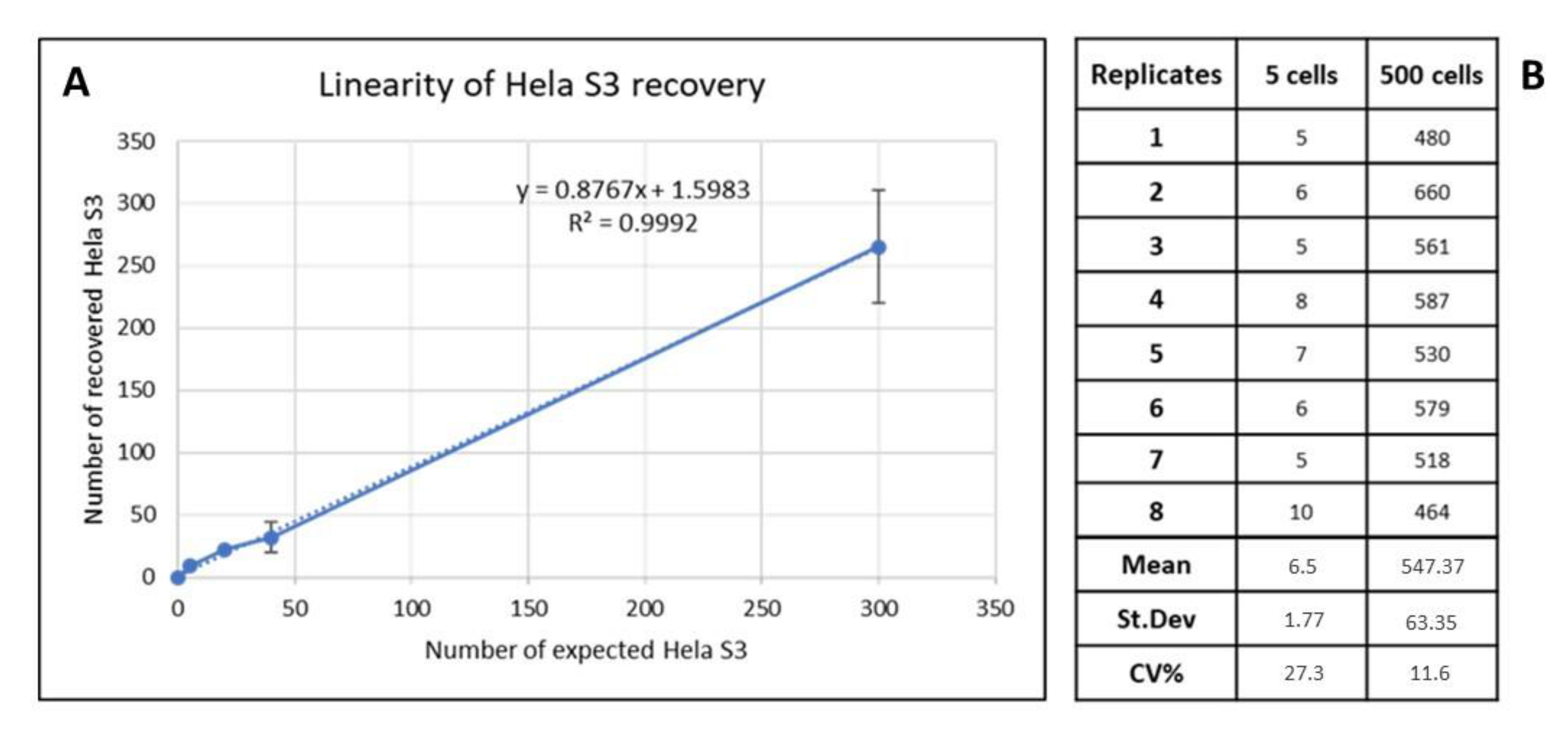
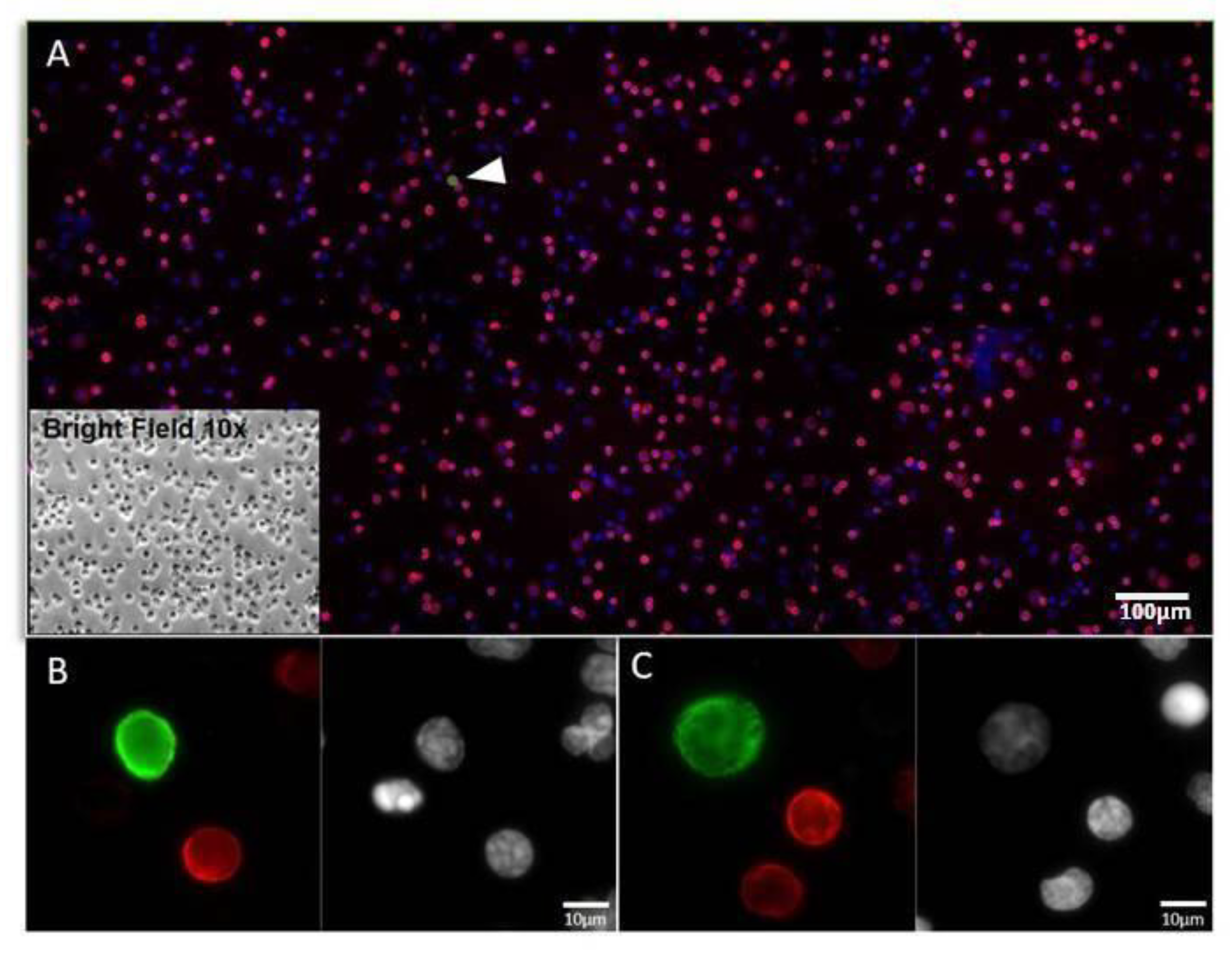
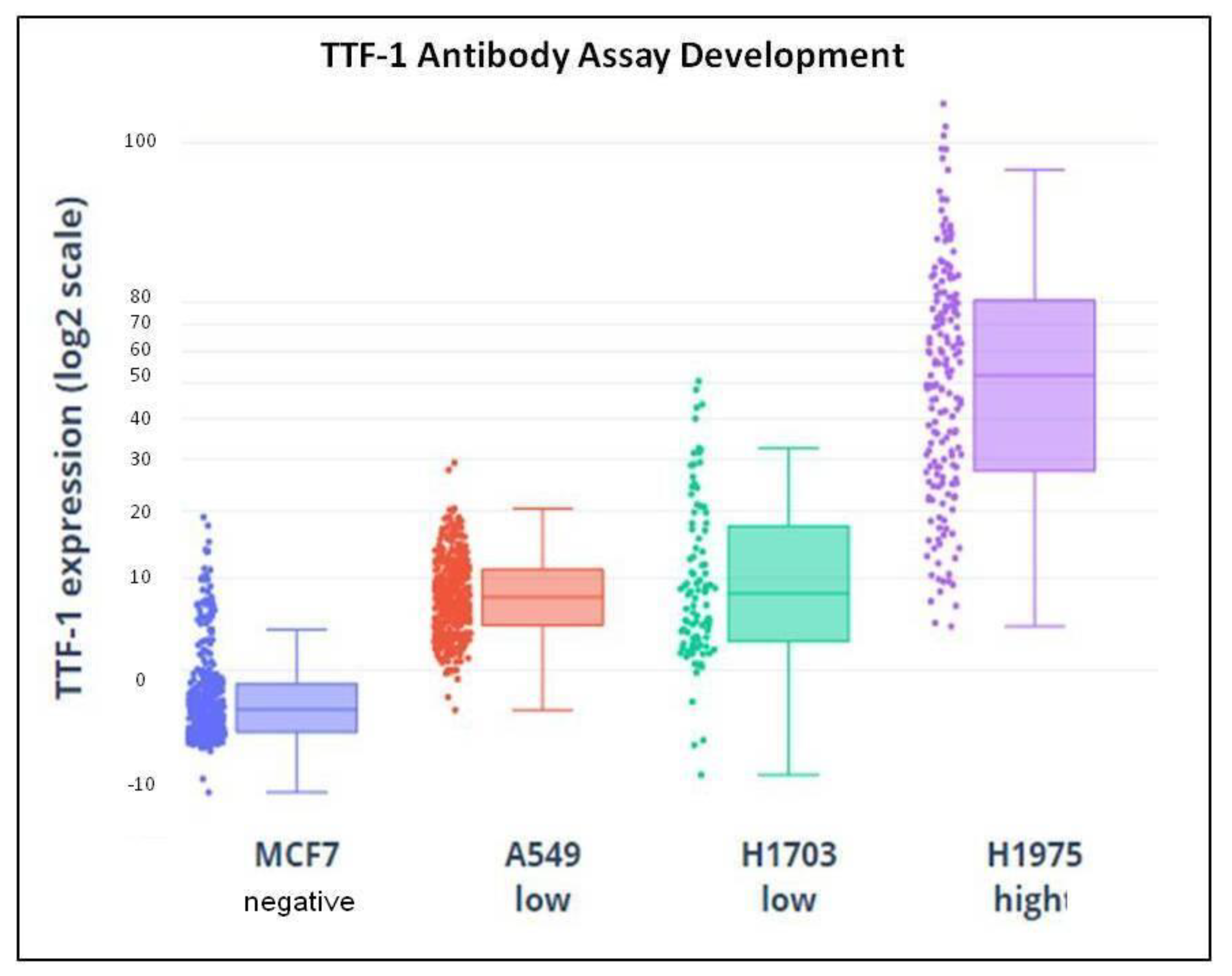
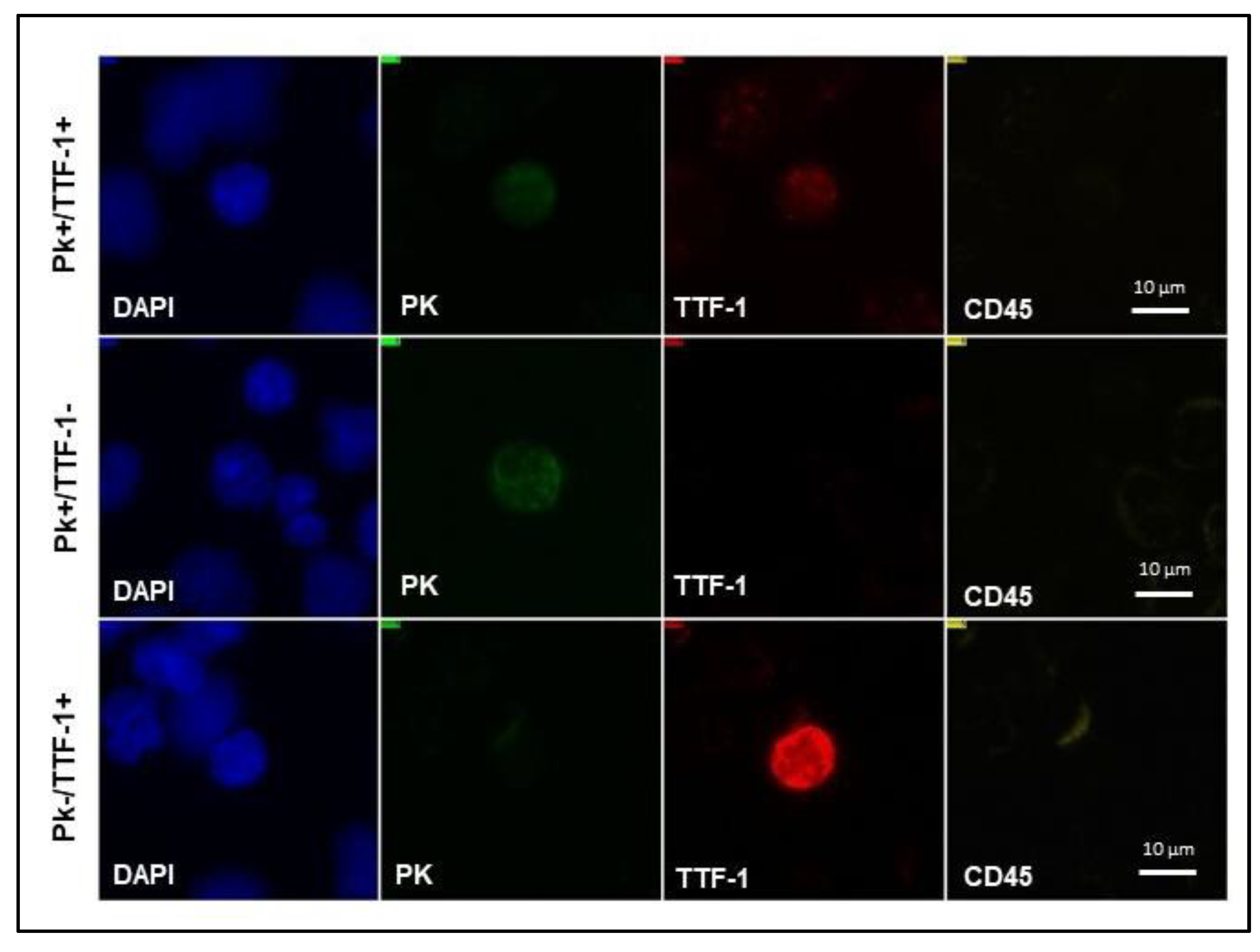
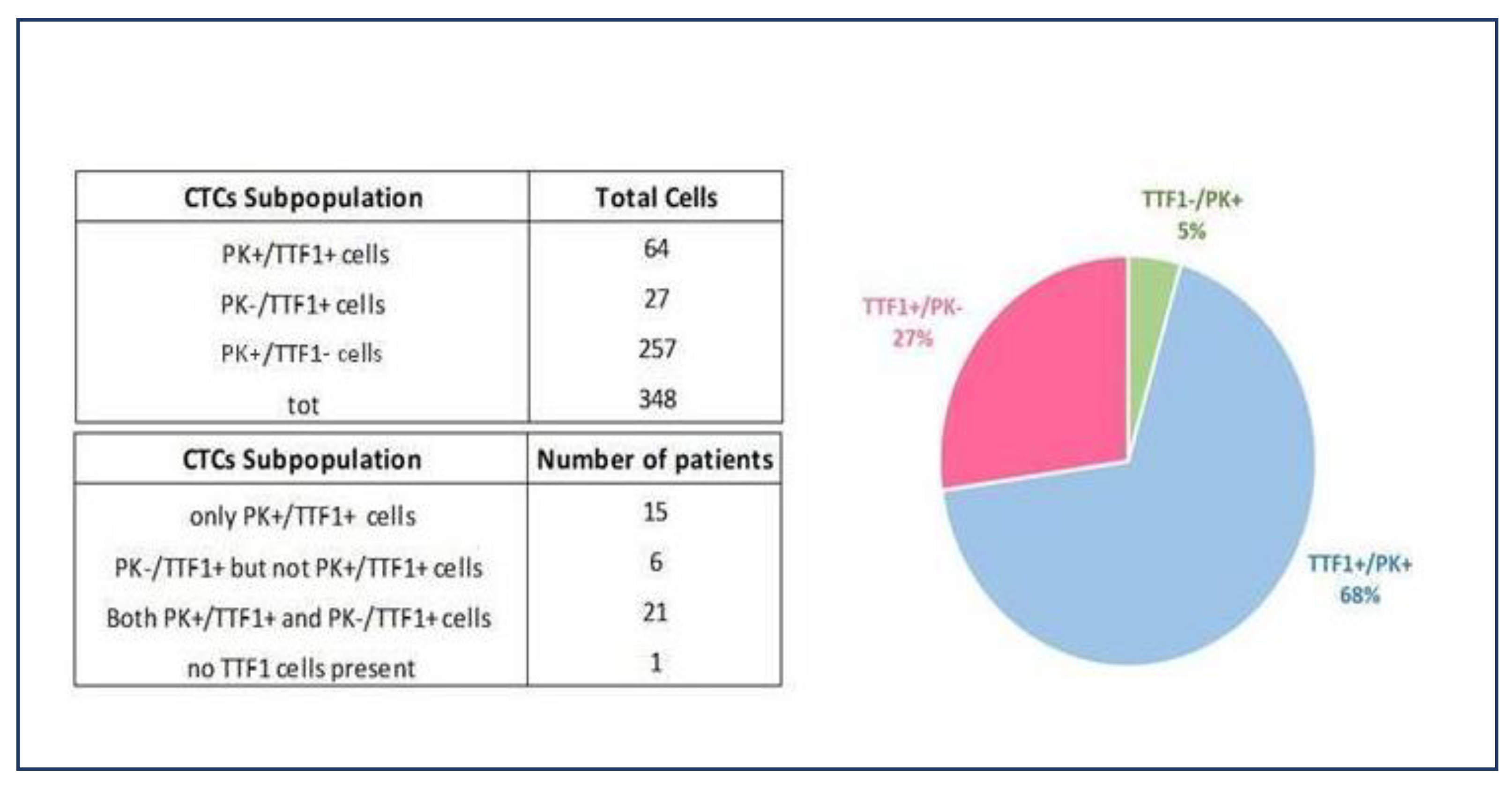
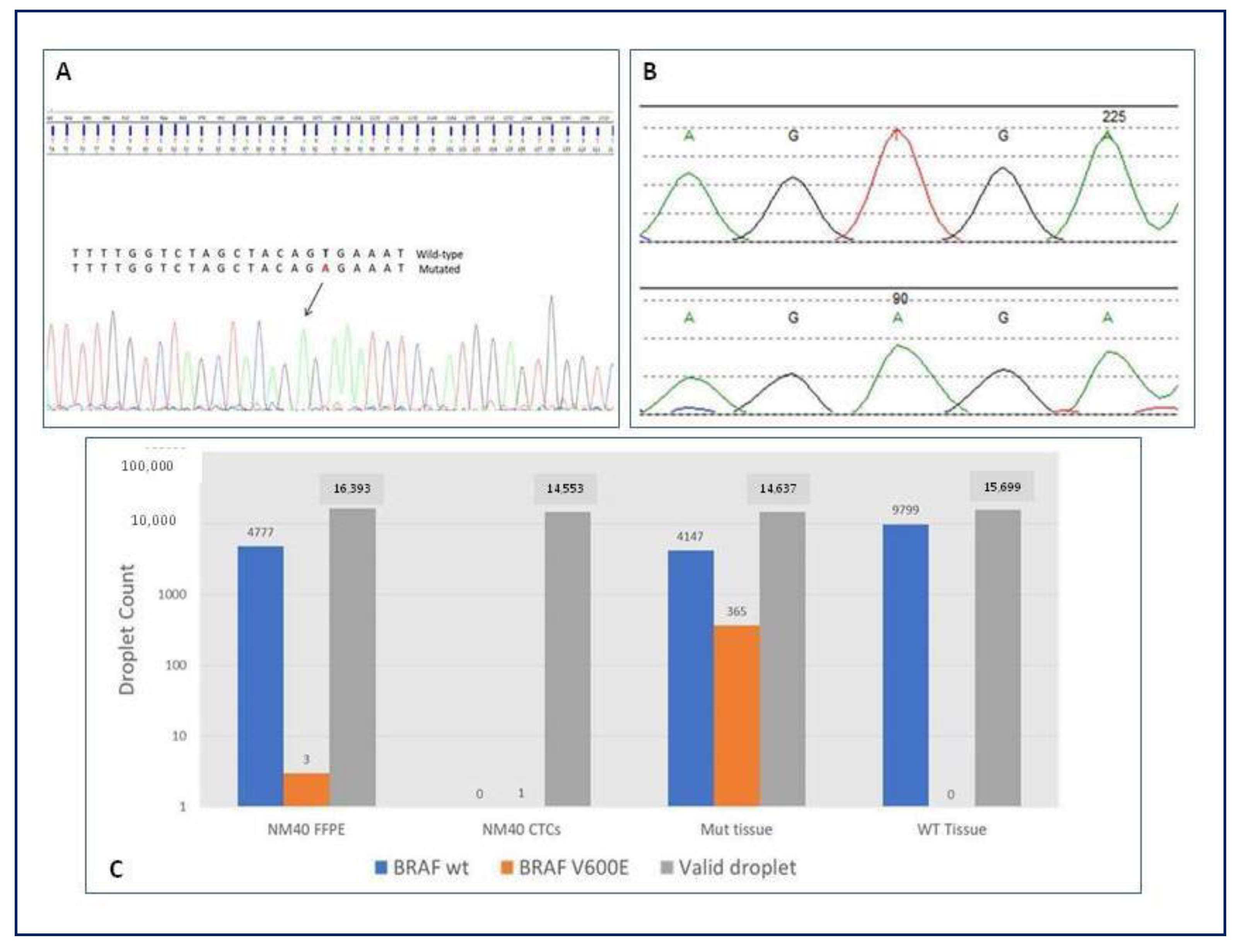
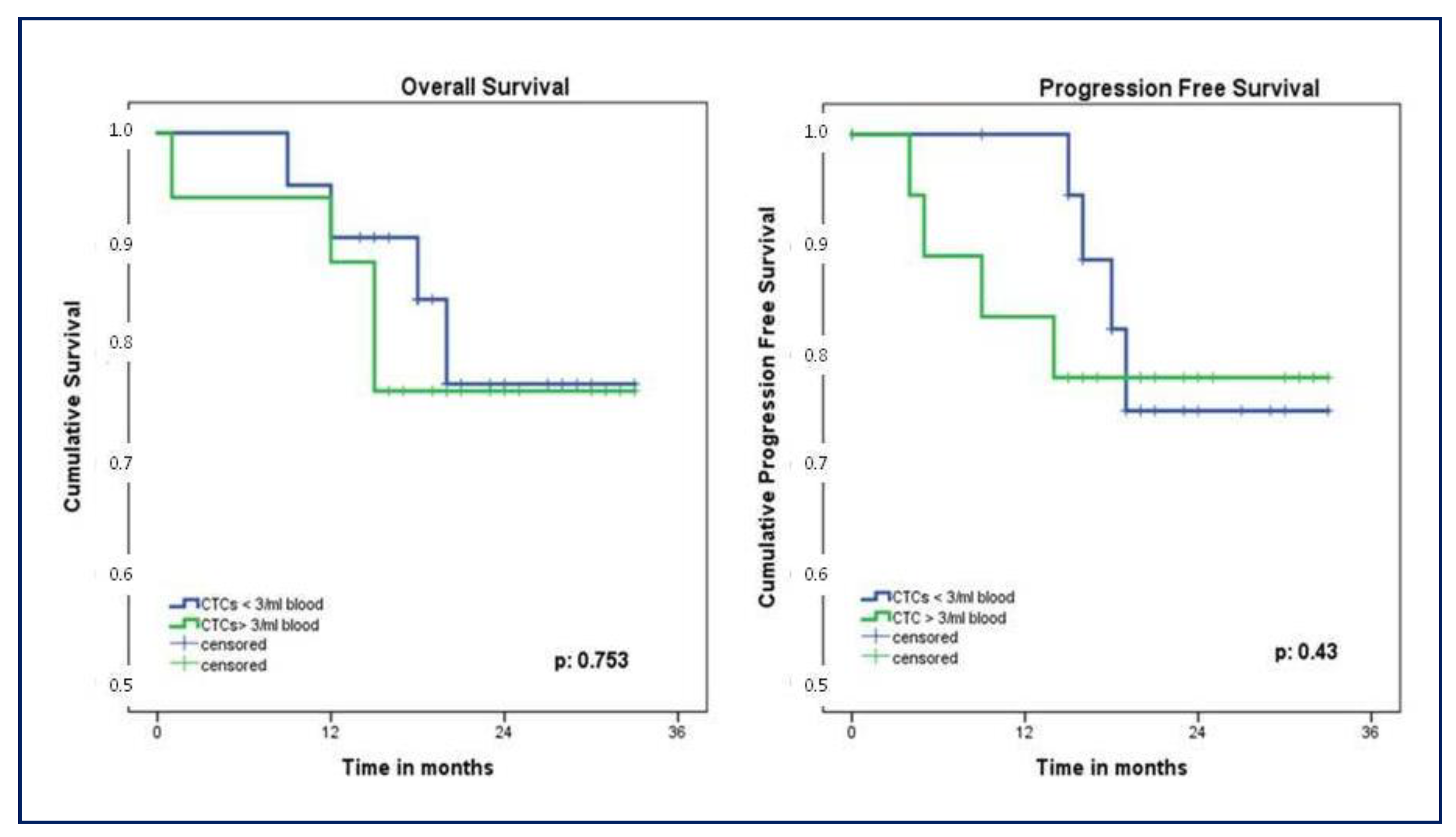
| Characteristics | NSCLC * Patients (n = 40) |
|---|---|
| Age, years (median, range) | 71 years (range 42–82) |
| Sex, n (%) | |
| Male | 30 (75%) |
| Female | 10 (25%) |
| Smoking history, n (%) | |
| No | 4 (10%) |
| Former | 27 (68%) |
| Current | 9 (22%) |
| Professional exposure, n (%) | |
| No | 24 (60%) |
| Yes | 16 (40%) |
| Hypertension, n (%) | 17 (42%) |
| Cardiovascular disease, n (%) | 14 (35%) |
| Diabetes, n (%) | 7 (18%) |
| Tumor size, n (%) | |
| <30 mm | 26 (65%) |
| >30 mm | 14 (35%) |
| Tumor location, n (%) | |
| Central | 16 (40%) |
| Peripheral | 24 (60%) |
| Pathology, n (%) | |
| Adenocarcinoma | 27 (68%) |
| Squamous cell carcinoma | 8 (20%) |
| Others | 5 (12%) |
| Adenocarcinoma patterns, n (%) | |
| Low-grade (lepidic) | 2 (7%) |
| Intermediate-grade (acinar or papillary) | 19 (70%) |
| High-grade (solid, micropapillary, or complex gland) | 6 (23%) |
| p-Stage, n (%) | |
| Stage I | 19 (48%) |
| Stage II | 21 (52%) |
| p-T Stage, n (%) | |
| T1 | 20 (50%) |
| T2 | 16 (40%) |
| T3 | 4 (10%) |
| p-N Stage, n (%) | |
| N0 | 30 (75%) |
| N1 | 10 (25%) |
| CTC †/mL blood | |
| median, range | 1.8 (0.2–22.2) |
| mean ± S.D. § | 4.7 ± 5.8 |
| Characteristics | CTCs * Count (mL/blood) | p-Value | |
|---|---|---|---|
| <3 | >3 | ||
| Age, years (median, range) | 71.5 years (range 63–82) | 68.5 years (range 42–78) | 0.047 |
| Sex, n (%) | |||
| Male | 19 (86%) | 11 (61%) | 0.067 |
| Female | 3(14%) | 7 (39%) | |
| Smoking history, n (%) | |||
| Never | 3 (14%) | 1 (6%) | 0.073 |
| Former | 17 (77%) | 10 (56%) | |
| Current | 2 (9%) | 7 (39%) | |
| Professional exposure, n (%) | |||
| No | 13 (59%) | 11 (61%) | 0.897 |
| Yes | 9 (41%) | 7 (39%) | |
| COPD #, FEV1 (%) § | |||
| < 30% | 1 (4.5%) | 0 (0%) | 0.685 |
| 30–60% | 1 (4.5%) | 3 (17%) | |
| 60–80% | 6 (27%) | 4 (22%) | |
| >80% | 14 (64%) | 11 (61%) | |
| Hypertension, n (%) | 9 (41%) | 8 (44%) | 0.822 |
| Cardiovascular disease, n (%) | 8 (36%) | 6 (33%) | 0.842 |
| Diabetes, n (%) | 2 (9%) | 5 (28%) | 0.122 |
| Tumor size, n (%) | |||
| ≤30 mm | 14 (64%) | 12 (67%) | 0.842 |
| >30 mm | 8 (36%) | 6 (33%) | |
| Tumor location, n (%) | |||
| Central | 7 (32%) | 9 (50%) | 0.243 |
| Peripheral | 15 (68%) | 9 (50%) | |
| Pathology, n (%) | |||
| Adenocarcinoma | 17 (77%) | 10 (56%) | 0.145 |
| Squamous cell carcinoma | 2 (9%) | 6 (33%) | 0.057 |
| Others | 3 (14%) | 2 (11%) | 0.81 |
| Adenocarcinoma patterns, n (%) | |||
| Low-grade (lepidic) | 0 (0%) | 2 (20%) | 0.05 |
| Intermediate-grade (acinar or papillary) | 12 (71%) | 7 (70%) | 0.974 |
| High-grade (solid, micropapillary or complex gland) | 5 (29%) | 2 (20%) | 0.59 |
| p-Stage, n (%) | |||
| Stage I | 9 (41%) | 10 (56%) | 0.613 |
| Stage II | 13 (59%) | 8 (44%) | |
| p-T Stage, n (%) | |||
| T1 | 10 (45%) | 10 (55%) | 0.916 |
| T2 | 9 (41%) | 7 (39%) | |
| T3 | 3 (14%) | 1 (6%) | |
| p-N Stage, n (%) | |||
| N0 | 16 (73%) | 14 (78%) | 0.886 |
| N1 | 6 (27%) | 4 (22%) | |
| New second malignancy, n (%) | |||
| Yes | 1 (4.5%) | 2 (11%) | 0.433 |
| Patients with CTCs TTF-1 ° +, n (%) | |||
| (Analysis performed on 22/40 patients) | 8 (89%) | 13 (100%) | 0.35 |
| Univariate Analysis | Multivariable Analysis | |||
|---|---|---|---|---|
| Variable and OS */PFS # | HR ° (95%CI §) | p-Value | HR ° (95%CI §) | p-Value |
| Variable and OS * | ||||
| Age | 1.172 (1.007–1.364) | 0.041 | 1.377 (1.053–1.800) | 0.020 |
| Gender | 34.023 (NA †) | 0.294 | ||
| pT-stage | 1.132 (0.459–2.789) | 0.788 | ||
| pN-stage | 0.326 (0.125–0.854) | 0.023 | 5.047 (1.194–21.341) | 0.028 |
| p-Stage | 2.177 (0.883–5.370) | 0.091 | ||
| Pathology | 1.884 (0.544–6.528) | 0.318 | ||
| Adenocarcinoma Grading | 4.039 (0.725–22.504) | 0.111 | ||
| CTCs a count (absolute number) | 0.911(0.715–1.161) | 0.452 | ||
| CTCs a count (>3 vs. < 3/mL blood) | 1.247 (0.311–4.990) | 0.755 | ||
| CTCs a TTF1+ b | 40.082 (NA †) | 0.275 | ||
| Variable and PFS # | ||||
| Age | 1.176 (0.941–1.470) | 0.154 | ||
| Gender | 36.380 (NA †) | 0.433 | ||
| pT-stage | 3.313 (1.291–8.502) | 0.013 | 0.151 | |
| pN-stage | 15.235 (NA †) | 0.198 | ||
| p-Stage | 8.122 (1.129–58.429) | 0.037 | 0.081 | |
| Pathology | 1.414 (0.246–8.123) | 0.698 | ||
| Adenocarcinoma Grading | 4.043 (0.599–27.309) | 0.152 | ||
| CTCs a count (absolute number) | 0.804 (0.514–1.257) | 0.339 | ||
| CTCs a count (>3 vs. <3/mL blood) | 0.404 (0.042–3.894) | 0.433 | ||
Disclaimer/Publisher’s Note: The statements, opinions and data contained in all publications are solely those of the individual author(s) and contributor(s) and not of MDPI and/or the editor(s). MDPI and/or the editor(s) disclaim responsibility for any injury to people or property resulting from any ideas, methods, instructions or products referred to in the content. |
© 2023 by the authors. Licensee MDPI, Basel, Switzerland. This article is an open access article distributed under the terms and conditions of the Creative Commons Attribution (CC BY) license (https://creativecommons.org/licenses/by/4.0/).
Share and Cite
Mastromarino, M.G.; Parini, S.; Azzolina, D.; Habib, S.; De Marni, M.L.; Luise, C.; Restelli, S.; Baietto, G.; Trisolini, E.; Massera, F.; et al. Liquid Biopsy Detecting Circulating Tumor Cells in Patients with Non-Small Cell Lung Cancer: Preliminary Results of a Pilot Study. Biomedicines 2023, 11, 153. https://doi.org/10.3390/biomedicines11010153
Mastromarino MG, Parini S, Azzolina D, Habib S, De Marni ML, Luise C, Restelli S, Baietto G, Trisolini E, Massera F, et al. Liquid Biopsy Detecting Circulating Tumor Cells in Patients with Non-Small Cell Lung Cancer: Preliminary Results of a Pilot Study. Biomedicines. 2023; 11(1):153. https://doi.org/10.3390/biomedicines11010153
Chicago/Turabian StyleMastromarino, Maria Giovanna, Sara Parini, Danila Azzolina, Sara Habib, Marzia Luigia De Marni, Chiara Luise, Silvia Restelli, Guido Baietto, Elena Trisolini, Fabio Massera, and et al. 2023. "Liquid Biopsy Detecting Circulating Tumor Cells in Patients with Non-Small Cell Lung Cancer: Preliminary Results of a Pilot Study" Biomedicines 11, no. 1: 153. https://doi.org/10.3390/biomedicines11010153
APA StyleMastromarino, M. G., Parini, S., Azzolina, D., Habib, S., De Marni, M. L., Luise, C., Restelli, S., Baietto, G., Trisolini, E., Massera, F., Papalia, E., Bora, G., Carbone, R., Casadio, C., Boldorini, R., & Rena, O. (2023). Liquid Biopsy Detecting Circulating Tumor Cells in Patients with Non-Small Cell Lung Cancer: Preliminary Results of a Pilot Study. Biomedicines, 11(1), 153. https://doi.org/10.3390/biomedicines11010153







